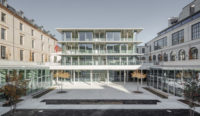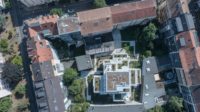Amid Changing Regulations, Moreau Kusunoki Completes a Singular Wood Tower in Paris
Paris

Architects & Firms
Planned in the 1980s and officially launched in 1991, Paris Rive Gauche is the French capital’s biggest redevelopment program since Haussmann’s transformation of the city in the mid-19th century. Stretching eastward along the Seine from the Gare d’Austerlitz to the city limits, it concerns over 320 acres of partly obsolete railroad infrastructure in the 13th arrondissement.
Thirty years on, the final and most difficult sector, in Bruneseau, is rising from the ground, on the strip of land running alongside Paris’s notorious boulevard périphérique, the eight-lane highway that rings the city. But traffic noise and infrastructure are not the only obstacles to redeveloping this part of the city, for it is littered with sundry industrial facilities and is also the point where the railroads fan out. Indeed so “hostile” did Yves Lion, Bruneseau’s coordinating architect, consider the sector that he advocated towers as the only building type capable of providing the density needed to satisfy developers’ profit margins in a context requiring costly foundations.

1

2
Located in rapidly and densely developing Bruneseau (1), the tower consists of joined 14-story and nine-story volumes (2). Photos © Maris Mezulis, click to enlarge.
For Lion’s proposal to be adopted, the Conseil de Paris had to vote in favor of abolishing the 121-foot height limit that had governed construction in the capital’s outer arrondissements since the mid-1970s—which it did, controversially, in 2010, only to reverse the decision just this April. In the 13 years between, two monumental towers have climbed toward the sky—Renzo Piano’s 525-foot-high courthouse in the 17th (2017) and Jean Nouvel’s 590-foot Tours Duo in Bruneseau (2022). Ground has also been broken on a third, Herzog & de Meuron’s much-contested 590-foot Tour Triangle in the 15th (due 2025). But the past 13 years have also seen completion of a good number of 164-foot-tall residential buildings—just below the legal limit that would require on-site fire personnel 24/7—of which this 77-apartment scheme by Paris-based Moreau Kusunoki is one.
Organized by SEMAPA, a publicly owned company that is overseeing Paris Rive Gauche, the 2018 design competition was “a race among developers, each of which teamed up with an architect, to see who could propose the most original project,” says Nicolas Moreau, one-half, alongside Hiroko Kusunoki, of the Franco-Japanese duo that won fame in the 2015 Guggenheim Helsinki contest. “The city was strongly represented on the jury and, as with the Réinventer Paris programs, was expecting innovation,” he continues, referring to the 2014 and 2017 open calls to find inventive yet commercially viable redevelopment schemes for various municipally owned sites. For French property giant Emerige, which has previously worked with Pritzker laureates David Chipperfield and RCR, Moreau Kusunoki proposed an experimental mass-timber tower that would push expression of the material about as far as it could go.
Located in the shadow of Nouvel’s off-kilter towers, Moreau Kusunoki’s building occupies a wedge-shaped site where the rue Jean-Baptiste-Berlier meets the Boulevard du Général-d’Armée-Jean-Simon, at a point where the latter takes the form of a bridge that spans the railroads and links to the river crossing. One of three mass-timber towers planned for Bruneseau, the project piles up two levels of underground parking, a ground and second floor containing a future art gallery and a restaurant, and, on the boulevard, 14 floors of apartments that range from studios to five-room duplexes, while the rear part of the building, also containing apartments, is articulated as a nine-floor volume. The architects considered using structural cross-laminated timber (CLT) panels, “but, to ensure full future adaptability, we opted for a mass-timber frame, with wooden floors and facades too,” explains Moreau. Their initial intention was to expose the frame externally, but they soon realized that would be impractical with respect to water penetration. Indeed, they admit, the project entailed a steep learning curve concerning the limits and pitfalls of timber construction.

The structural frame is expressed on the exterior as a grid of glulam members clad in weather-resistant larch. Photos © Maris Mezulis
Rather than the structurally pure object Moreau Kusunoki was aiming for, the result is a clever hybrid, dressed up to resemble the initial intention but actually involving three different construction logics. As in many mass-timber towers, the base and core are concrete. A complex piece of civil engineering, the four-story base (garage and levels 1 and 2) cantilevers over the boulevard bridge at the front, is reinforced to bear the loads of a planned metro extension at the rear, and incorporates measures to eliminate train vibration. Featuring spruce glulam columns, as well as glulam beams at its perimeter, the mass-timber frame also incorporates steel, which spans the interior. This is because, for fire resistance, the glulam members are oversized, which would have made ceiling heights too low had they been used throughout. To prevent water penetration, the frame is enclosed behind facade panels—a prefabricated sandwich of CLT and timber-shaving insulation. But, just as at Mies van der Rohe’s Seagram building, in New York, the structure is expressed outside in decorative form—instead of Mies’s bronze, we find larch-clad string courses and pilasters. Finally, the precast concrete balconies are carried by exoskeletons that rise up the building like scaffolding, their glulam members clad in hard-wearing larch for weather protection.

3

4
The concrete base, on the ground floor, will house an art gallery with a dramatic spiral stair (3), the residential lobby (4), and a restaurant. Photos © Maris Mezulis
Except for the glulam columns, the interior mass-timber elements are concealed, wrapped in protective layers of concrete, insulation, and plasterboard. But, on the exterior, the prefabricated facade panels put wood on display, since they are clad in a layer of charred timber, a traditional Japanese technique the architects first proposed for the Guggenheim. For Moreau, this is a stable, fire-resistant finish whose darkness will hide modifications, while for Kusunoki it is part of a philosophy of wabi sabi, a worldview based on the acceptance of transience and imperfection, expressed here in the symphony of grays that make up the elevations: differently colored and textured concrete, charcoal, and pre-aged larch.
Frustrated by the compromises they faced in Bruneseau, the architects devised workarounds, including setting columns back from the facade, to achieve an all-timber exposed frame for a competition in Montpellier. But it now seems unlikely that they will achieve their dream in France. Construction of their Bruneseau building began just days before the French fire service issued a circular, on January 1, 2020, prohibiting exposed external wood until further notice. Along with the recently reinstated height limits, these new restrictions mean that nothing quite like this timber tower will be seen in Paris again.
Click plan to enlarge

Click plans to enlarge

Click drawings to enlarge


Credits
Architect:
Moreau Kusunoki —Nicolas Moreau, Hiroko Kusunoki, principals; Nastassia Nasser, project manager, competition and design development; Chiara Munari, Maxime Aupiais, Elise Niogret, assistants, design development; Seyfedine Bentili, project manager, construction
Consultants:
C&E (structure and facade); Edeis (m/e/p); MOZ Paysage (landscape); ACOUSTB (acoustics); Citae (sustainability); Athlance (timber); BTP (code and security); Yann Kersalé + BOA (lighting)
General Contractor:
Bouygues
Client:
Emerige
Size:
70,200 square feet
Cost:
$21 million (construction)
Completion Date:
June 2023
Sources
Wood-Steel Structure:
Gustave, Arborsphere, KLH, JPF Ducret, Binderholz, Pollmeier
Wood Facades:
Techniwood, Ligne alpes
Windows:
MC France
Doors:
Prometalic, Legallais, Malerba
Door Hardware:
Moreau Kusunoki with Izé



Moreau-Kusunoki-en-association-avec-Frida-Escobedo-Studio_LD-(72-dpi).jpg?height=200&t=1719527951&width=200)
